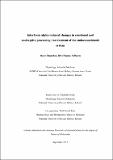| dc.description.abstract | Interferon-α (IFN-α) is a pro-inflammatory cytokine used for the treatment of hepatitis B and C as well as various malignancies. However, therapy is often associated with neuropsychiatric side effects, including depression and anxiety (Schaefer et al., 2002, Raison et al., 2005), as well as the development of painful symptoms (Shakoor et al., 2010, Nogueira et al., 2012, Capuron et al., 2002). Several preclinical studies which have employed IFN-α for the investigation of inflammation-induced depression have yielded varying results and to date, no study has evaluated the effect of repeated IFN-α treatment on nociceptive behaviour. Therefore, this thesis sought to devise an experimental protocol that would mimic the clinical situation and provide a robust and reproducible model of IFN-α-induced depression and hyperalgesia. The results demonstrated that repeated subcutaneous administration of a high, but not low, dose of IFN-α resulted in depressive-like behaviour and hyperalgesia to a noxious inflammatory stimulus in C57Bl/6 mice. Establishment of this model of IFN-α-induced depression and pain subsequently allowed for the evaluation of possible neurobiological substrates underpinning concurrent changes in emotional and nociceptive responding. Given the recognised role for the endocannabinoid system in emotional and nociceptive responding, we chose to examine if changes existed in this system following repeated administration of IFN-α. The data revealed no change in the levels of the endocannabinoids or expression of the receptors or enzymes responsible for metabolism of the endocannabinoids between saline and IFN-α-treated mice. However, in the presence of a noxious stimulus, levels of the endocannabinoids, AEA and 2-AG, were increased in the PAG and RVM, key components of the descending pain pathway in IFN-α-treated animals. In comparison, formalin administration increased levels of 2-AG, AEA and related N-acylethanolamines at the site of injury in saline-, but not IFN-α-treated animals. Thus, IFN-α-treated mice may have an inability to mobilise endocannabinoids at the site of injury in response to a noxious stimulus, an effect which may underlie the hyperalgesia observed. As such, the remaining studies evaluated the effect of enhancing endocannabinoid tone either at the site of injury (paw) or globally, on formalin-evoked nociceptive behaviour. Inhibition of FAAH, the primary enzyme responsible for the metabolism of AEA and N-acylethanolamines, or inhibition of MAGL, the 2-AG-metabolising enzyme, at the level of the paw, attenuated IFN-α-induced hyperalgesia, without altering formalin-evoked nociceptive behaviour in saline-treated animals. These data provide further support for an impaired ability of IFN-α-treated mice to engage the peripheral endocannabinoid system in response to a noxious stimulus, an effect which underlies the hyperalgesia observed in these animals. In comparison, systemic MAGL, but not FAAH, inhibition attenuated formalin-evoked nociceptive behaviour in both saline- and IFN-α-treated animals, indicating that enhancing 2-AG tone can elicit analgesic effects in the presence and absence of a depressive-like state. Taken together, this thesis has demonstrated for the first time that it is possible to establish a preclinical mouse model of IFN-α-induced depression and pain behaviour, and highlight a role for the endocannabinoid system in mediating and modulating IFN-α-related hyperalgesia. | en_IE |
| dc.local.note | This thesis investigated the potential mechanisms underlying inflammation-induced depression and associated pain disorder. The work presented assessed this through the administration of an inflammatory stimulus in mice, following which, animals displayed depressive-like and hyperalgesic behaviour. Neuroimmune, neuroendocrine and neurotransmitter systems were investigated for their potential role in the observed hyperalgesia and changes in endocannabinoid signalling were detected in components of the descending pain pathway and the site of injury itself, in response to a painful stimulus. Furthermore, local manipulation of this endogenous system alleviated inflammation-induced hypersensitivities while global manipulation of the system attenuated nociceptive behaviour overall. Thus, the data presented demonstrated that it is possible to establish a preclinical mouse model of inflammation-induced depression and pain behaviour, and highlighted a role for the endocannabinoid system in mediating and modulating such hypersensitivity. | en_IE |


